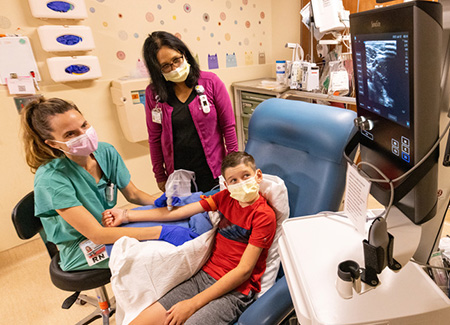Study shows emergency department preparedness cuts mortality risk in children
A new study funded by the National Institutes of Health shows emergency departments that are better prepared to care for children have lower pediatric mortality rates.

The six-year study was co-authored by Nathan Kuppermann, chair of the Department of Emergency Medicine at UC Davis Health. It involved nearly 800,000 children receiving emergency care in 11 states.
The project was led by Craig Newgard from Oregon Health Sciences University. The researchers examined the associations between high pediatric readiness and mortality rates. They looked at both in-hospital mortality and one-year mortality among acutely ill and injured children receiving emergency care.
“The care a child receives in the emergency department can set them on a path to survival or not,” Kuppermann explained. “The goal of this study was to show the importance of emergency departments being prepared to care for acutely sick and injured children and ensure that every child has access to high-quality emergency care.”
The pediatric readiness of emergency departments was measured using the weighted Pediatric Readiness Score (range, 0 to 100) with six domains of preparedness. They include:
- Quality improvement
- Care coordination
- Personnel and competencies
- Policies and procedures
- Patient safety
- Availability of key equipment and supplies
The investigators found that injured children cared for in high readiness emergency departments had a 60% reduced chance of in-hospital death. Those with acute medical conditions had a 76% reduction. The team estimated that if all low readiness emergency departments increased to high readiness, lives could have been saved: 288 lives among those injured and 1,154 lives among those with acute illness.
The goal of this study was to show the importance of emergency departments being prepared to care for acutely sick and injured children and ensure that every child has access to high-quality emergency care.” —Nathan Kuppermann
The team was able to measure outcomes to one year in 545,921 children. There were 1,316 deaths in the injury group during this time, 693 of which occurred in the emergency department, 477 as in-patients and 146 after hospital discharge. In comparison, there were 6,635 deaths in the medical group during this time – 4,150 in the emergency department, 759 as in-patients and 1,726 after discharge.
Childhood deaths in low pediatric readiness emergency departments occurred in a shorter time frame (within two days) than departments with the highest readiness.
A total of 90.6% of injury deaths, and 88.5% of medical deaths, took place within two days in low readiness hospitals. That’s compared to 72.5% of injury deaths and 56.8% of medical deaths in high readiness hospitals.
Children treated in high-readiness emergency departments had the lowest risk of death at one year.
Authors of the study believe these results have national policy implications. National hospital accreditation organizations could consider adopting high emergency department pediatric readiness standards for all hospitals caring for children, with similar state-level accreditation practices.
"Our findings show that children cared for in emergency departments with high pediatric readiness standards have a lower risk of death after critical illness or injury," Kuppermann said. “Therefore, it is imperative for all emergency departments to implement robust pediatric readiness standards so they can be prepared to help save the lives of the children they serve.”




